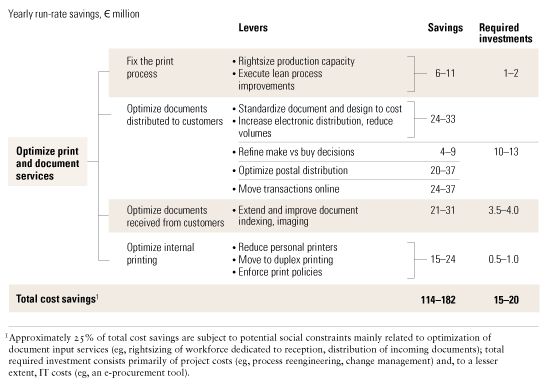Situation
Managing the flow of documents is an immense, complex, and critical task for many sectors, particularly financial services, government, long-distance marketing, and publishing. The rising tide includes printed and electronic documents sent to customers (bills, marketing brochures) and those received from them (insurance claims, changes in personal information), as well as internal documents for employees.
Most organizations handle documents in scattered units that manage output services: the design, composition, and production of documents for physical and electronic distribution. The units also manage input services: receiving, sorting, and storing incoming documents. A typical global financial institution might spend 0.5 percent of its revenues on print and document services—a significant sum.
Recently, a big insurance company looking for savings to finance growth decided to target document operations. Spending was high and evidence of waste widespread. In some locations, under a third of all marketing brochures reached designated customers; the rest sat in storage for years. Fragmented communications hurt the company’s brand image—logos, for example, were printed in different sizes and colors.
Top executives thought an integrated document-management strategy could cut costs and improve operations significantly. An analysis revealed that over three years these costs might fall by up to €150 million ($215 million)—a third of the total. The analysis also revealed the potential for significant image and branding improvements.
Complication
Before the company could begin rationalizing the system and making improvements, it faced a major obstacle: document service units, each with a different operating model, were dispersed across more than 30 nations. At the same time, several local executives, worrying that the centralization of print and document services would diminish the agility and quality of local marketing campaigns, were reluctant to relinquish control over a function that directly touched important customers.
Resolution
To reform the system, the company established a document advisory function, which received umbrella authority over a wide range of tasks. It assumed end-to-end responsibility for all document processes: printing, composition, archiving, and supplier management, as well as traditional and electronic distribution. Its broader mission was to create value across the chain of operations in a number of ways: managing demand for documents more effectively, ensuring that designs followed cost guidelines, standardizing processes, promoting electronic distribution, and establishing more individualized marketing communications.
To meet this mandate, the document advisory function established national teams, typically comprising five members, that included people with several areas of expertise: artistic skills and the ability to align practices with the new corporate norms, the technical skills needed to understand IT processes and tools, and basic managerial and leadership skills. While these teams reported to the local COO, the corporate center set their incentives and goals—for example, targets for paper consumption or the expected use of electronic documents. A leader of each team served on the group’s governance body and was responsible for sharing knowledge and encouraging best practices. Simply by following a directive to standardize the weight and format of paper for client communications, one country operation cut production costs by 10 percent.
The local reporting structure helped to mitigate country executives’ concerns about ceding too much control over document operations. Higher-level coordination and goal setting allowed the company to standardize practices and realize broad economies.
Ultimately, the document advisory function enabled the company to achieve its cost reduction target of €150 million over a three-year period. What’s more, the new approach required relatively little investment—about €15 million over three years—since the company relied principally on managerial and organizational initiatives.
Implications
An integrated document services strategy can realize significant savings for many organizations operating across a vast spectrum of industries (exhibit). Given the current challenging environment, this strategy will suit many companies looking for significant cost reductions but under pressure to minimize investment. The structure also produces value beyond the tangible cost savings. Branding, for example, becomes more effective when companies standardize the visual identity and language of their marketing. US customer communications in financial services are highly regulated, so better document management may reduce compliance risks too.
Documented savings

Organizations can also improve the customer experience by using document services to individualize communications. And one company, acting on the advisory function’s advice, attached marketing communications to its clients’ transaction documents. By reducing paper consumption and increasing electronic communications, the company met its customer commitments while “greening” operations.